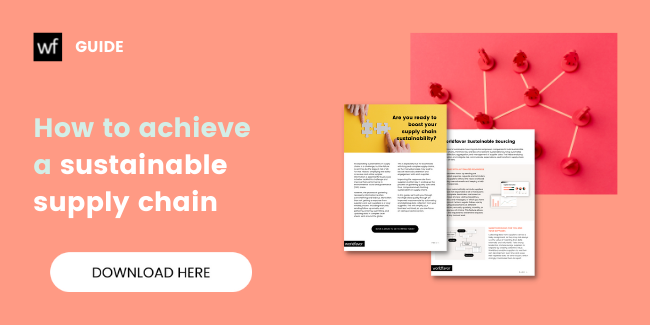6 ways to deal with high risk ingredients in the food supply chain

It is no surprise that the Food and Agriculture sector faces many obstacles to becoming sustainable, and for some specific markets, the traceability of ingredients is constantly under scrutiny. It is well documented that the production of so-called “high-risk ingredients”, such as sugar, coffee, soy, palm oil, and bananas, has severe negative impacts on the planet and people, such as deforestation and child labor. For businesses, these issues often translate to reputational and financial risks for companies if not managed correctly.
With the growing demand from consumers for sustainably grown products, coupled with new regulations– more companies are adopting sustainable sourcing commitments to buy certified ingredients or replace the unsustainable ones with better alternatives.
However, the ongoing conflict between Russia and Ukraine – the world’s biggest sunflower oil producers – is once again shedding light on how hard it is to assess and mitigate risks in complex dynamic food supply chains. The shortage of sunflower oil exports resulting from the war is cornering some food companies relying on the ingredients to use palm oil as a substitute to make sure they are still in business. The undesired comeback of palm oil in Europe after the hard-fought effort to cut down the ingredients raises the issue of high-risk ingredients again: What are they? And what actions can food companies undertake to enable a resilient and sustainable supply chain? In this blog, we will dive deep into all things high-risk ingredients and walk you through how to close the gap between commitment to do good and taking real action!
What are high-risk ingredients and why are they an issue?
Like all agricultural products, land areas are needed to cultivate these crops, affecting the landscape, local communities and the environment. High-risk ingredients, such as palm oil, soy sugar, coffee and cacao are goods strongly linked to Environmental, Social and Governance (ESG) vulnerabilities in the supply chain – particularly harmful to the environment and people at the production stage. These risks include but are not limited to climate change, deforestation, large reduction of biodiversity, the use of chemicals that negatively affect the environment and human health, human rights violation, and land conflict.
More companies revert to palm oil to replace sunflower oil as a consequence of Russia’s invasion
One example of high-risk ingredients is palm oil, which is one of the most used oils in consumer products but, when unsustainably produced, causes severe damage to the rainforests. The unsustainable clearing methods for palm oil production destroy carbon-rich tropical forests and peatlands, making it a significant contributor to global warming and threatening the habitats of several endangered species, including orangutans, elephants, and tigers.
As a result, businesses and governments have been pressured to find alternatives to unsustainable production. One common approach has been to replace it with other vegetable oils with similar properties, such as sunflower oil. Together, Ukraine and Russia account for 73% of the global supply of sunflower oil – and Putin’s invasion of Ukraine has caused companies that once removed palm oil from their production to revert to it as a last resort to stay in business due to the sunflower oil. In 2018, the UK’s leading frozen food specialist Iceland removed palm oil as an ingredient from all its own-label products by increasing its reliance on sunflower oil. However, as a result of Putin’s invasion of Ukraine, the company announced that it “with huge regret” will temporarily revert to using palm oil due to the circumstances.
As evidenced, removing one product from the value chain can entail other unforeseen risks and might not always be the best decision. Instead, WWF strongly advocates companies to be a driver of change to make the production of high-risk ingredients more ethical through supporting models of sustainable production and increasing their transparency.
Stronger Legislation on high-risk ingredients is on the rise
Companies lacking knowledge of where their high-risk ingredients come from and the procedure in place don’t only risk serious reputational concerns but also pose greater legal risks as more and stronger regulations are being introduced. In 2021, Environmental Act 2021 became part of UK law, which will make it illegal for large businesses in the UK to use commodities whose production is associated with large-scale forest loss. The same year, the EU proposed a new regulation on deforestation-free products. The regulation aims to minimize EU-driven deforestation by boosting market opportunities for sustainable products and eliminating unsustainable producers exporting to the EU market – and failure to comply could result in fines of up to 4% of a company's turnover in an EU country. The Open Public Consultation for this legislative proposal gathered more than 1.2 million responses – the second most popular in the history of the EU. If anything, this shows the overwhelming support from European citizens and consumers for EU action to tackle deforestation associated with high-risk ingredients.
What can food and agriculture businesses do to take control of ESG risks linked to high-risk ingredients?
Many companies are already taking action against high-risk ingredients by committing to mitigating and eliminating the risks associated with such ingredients, such as deforestation and modern slavery. However, it is not enough to just communicate aims and goals to actually make a difference – businesses need full disclosure from the farm gate to the end consumer to substantiate their claims and commitments. Given the depth and breadth of the food supply chain, tracing and getting a hold of every tier of the chain requires a lot of work and resources, but the cost of doing nothing is much greater.
To meet the consumers' demand, prepare for upcoming regulations and promote sustainable production of high-risk ingredients, companies should adopt the following six steps:
1. Formulate policies and commitments related to high-risk ingredients: Comply with the relevant frameworks and policies, such as the Modern Slavery Act and Rainforest Accountability Framework, to review, identify gaps and measure compliance to drive genuine improvements along your supply chain.
2. Dig deeper: Map out the organization’s entire supply chain. Many companies are settling with insights and monitoring risk assessment for their direct suppliers only. But to be frank, the most severe risks are usually hidden deep down in the supply chain, and they are usually the ones companies must keep an eye on.
3. Carry out a risk assessment: Identify the parts of your business operations and supply chains where risks associated with high-risk ingredients are currently occurring – or might happen in the future.
4. Establish processes to assess and manage spotted risks: This can include establishing human and environmental due diligence processes and setting up KPIs to monitor the effectiveness of operations and improvements.
5. Conduct scenario planning exercises in uncertain times: the food sector has been confronted with some hard lessons in supply chain resilience over the past few years. Conduct scenario planning exercises helps businesses get familiar with the ongoing crisis, its potential risks, and opportunities. Having various scenarios and associated risk mitigation responses identified brings more confidence in your decision-making in these strange times.
These turbulent times also affect how companies should assess and manage their risks to strengthen their resilience. Read our blog to learn more about how companies manage their supply chain risk in uncertain times.
6. Act on your insights: Carry out periodic internal or third-party reviews or on-site audits where risks are identified. Evaluate risks regularly to reach a continuous cycle of identifying risky businesses and disruptions before they become a problem.
How Worldfavor can help
Global food supply chains are complex and require in-depth information to identify vulnerabilities to build resilience. Worldfavor is a sustainability platform that is helping companies in the food and agriculture sector to gain visibility on every tier of their far-reaching supply chain and manage their ESG risks in one place. Get the insights you need to take proactive action by automating the analyzes of your supply chain and risk assessments. Managing complex supply chains have never been easier!
Related blog posts you might like:







%20as%20the%20deadline%20approaches.%20Learn%20about%20compliance%20requirements%2c%20potential%20delays%2c%20and%20key%20updates..png)

